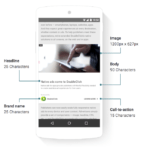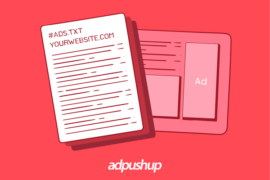Users don’t hate ads, they just don’t like the intrusive ones. But the cost of intrusive ads is being paid by the entire advertising industry as the usage of ad blockers grows. As the leading industry trade association, IAB is restlessly working to improve the quality of ads on the web.
It is not too late for the industry to acknowledge this mistake and make up for it. That’s what IAB thrives to achieve.
The Interactive Advertising Bureau (IAB) is a trade group that empowers marketing and media industry to thrive in the digital economy by advising on the sales, delivery, and optimization of digital advertising and marketing campaigns.
July 2017, IAB launched Standard Ad Unit Portfolio featuring flexible ad units that maintain their aspect-ratio while resizing to fit the users’ display on mobile, tablet or desktop.
This new generation of ad units also incorporates LEAN principles of being lightweight, encrypted, AdChoice supported, and non-invasive delivery. The portfolio is built using HTML5 and includes guidelines for delivering ads using emerging technology such as augmented reality (AR), virtual reality (VR), 360-degree video ads, social media, and emoji ad messaging.
This final release of the new ‘IAB Standard Ad Unit Portfolio’ is a reflection of the industry’s commitment to creating beautiful, user-friendly digital advertising that can easily scale. Whether on a mobile phone, tablet, or laptop computer, these ad units offer responsive solutions that captivate and inspire, while guidance for emerging platforms offers insights on how to approach consumers in new ways—even if they are looking at the world through a virtual reality headset.
Alanna Gombert, SVP, Technology and Ad Operations, IAB, and GM, IAB Tech Lab
What is the IAB New Ad Portfolio?

With a new ad portfolio, IAB wants ads to be lightweight and cross-screen compatible. This standard is designed for display ads, native ads, and modern 360° ad formats (used for augmented reality).
The technology emphasis on better user engagement, faster load performance, and non-disruptive ad content. The user is on the page to consume the content, he/she should not be deprived of that. Next, consumers should have control over the ads they are seeing. And finally, the users should have the choice to opt-out of seeing ads.
The new ad portfolio includes LEAN standards.
What Does it Mean to be LEAN?
LEAN stands for:
L – Lightweight ads
E – Encryption (HTTPS)
A – Allowing Choice (adChoices, Transparency & Consent Framework)
N – Non-invasive ads (Coalition for Better Ads)
IAB strongly believes the use of ad blockers is wrong. It is a major threat to the ad industry and IAB plans to counter it with LEAN standards.
LEAN addresses all the problems users face because of the ads. For instance, lightweight ads would make the website loading smooth. Encryption will protect the user data from being leaked and misused. Next, allowing choices mean to bring transparency, where the publisher would pre-state the usage of user details. Finally, non-intrusive ads directly focus on the user experience and methods to improve it.
What Are the Exact Protocols?
LEAN offers a road-map towards a better ad environment. Here are further standards that come under it:
DigiTrust ID: A Substitute for Cookies
DigiTrust is a non-profit, industry-wide collaboration of adtech companies working together to improve the digital experience for publishers, advertisers, users, and third-parties.
Now acquired by IAB, DigiTrust aims to reduce the number of third-party requests on the webpage during the ad delivery process. The problem with the standard targeting method is that it uses cookie syncing. In order to sync cookies, multiple ad requests need to be made. This slows down the entire ad delivery process.
Solution? DigiTrust ID. It creates a pseudonymous user token that acts and works like cookies. DigiTrust members are able to access the DigiTrust ID which is designed to be propagated by and between its members in lieu of billions of proprietary tokens and trackers on Web pages daily.
Transparency and Consent Framework
This protocol is designed to give users a choice. Meaning, this supports the use of privacy and consent laws like GDPR and CCPA.
IAB empowers the Digital Advertising Alliance and the use of adChoice. When users click on the adChoice icon, it tells them about the collected details and how this data is going to be used. Here, users get answers to questions like why this ad was shown to them, which advertiser placed this ad, what choice does the user has, and other similar options.
The problem right now is that the industry has varied laws for specific geographical locations. With the Transparency and Consent Framework, IAB wants to create global standards followed by all digital publishers.
Coalition for Better Ads: Non-intrusive Ads
Better Ad Standards is another industry-wide collaboration to fight the intrusive ads. The Coalition for Better Ads points out various ad formats that are voted intrusive by users. This data is collected by conducting comprehensive research.
It points out that pop-up, auto-play video ads with sound on, and prestitial ads with the countdown is the most intrusive ad format for desktop. Similarly, for mobile devices, ad density higher than 30%, and flashing animated ads are most intrusive. The research narrows down more such ad types for both desktop and mobile devices.
Adtech giants, like Google, are already onboard on the adoption and use of only non-intrusive ads. With services like Chrome ad filtering in action, we can see the end of intrusive ads, once and for all.
Open Measurement SDK: In-app Viewability Without Discrepancy
Open Measurement Software Development Kit (OM SDK) is an IAB technology that offers common code and libraries to simplify ad measurement in the mobile app environment by a third-party vendor. Publishers integrate their applications with OM SDK to send measurement signals to API. Then, this API signals the Open Measurement Interface Definition (OMID) to collect the tag data and show the required measurement.
“The Open Measurement SDK gives our advertising partners an unprecedented level of transparency and measurement by enabling the independent, third-party reporting of their choice. Currently, around 75% of our inventory is OM-enabled and measurement is no longer the inhibitor it once was,” said Paul Longhenry, Senior Vice President of Strategy at Tapjoy.
OM SDK is to tackle two major issues when it comes to measurement of mobile application ad reporting:
- Discrepancy: The use of a standard library ensures that viewability and other metrics are calculated using the same protocol. Hence, discrepancy in measurement is avoided.
- Increased app sizes: Integrating more than one SDK (in case publishers are working with multiple vendors) means an increase in publisher’s app size. An increased app size not only discourages users from downloading but also makes the application slow during the use.
VAST 4.x: Guidelines for Video Ads
Video ads are trusted by more than 35% of online users. And looking at the trend, global internet video traffic will easily account for 80% of internet traffic.
There is no doubt, videos are more engaging than the display ads, hence with growing popularity, the technology around it also improving.
In order to make video ad rendering and delivery better, IAB is filling technological gaps with VAST 4.x technology. VAST 4.2 has recently been aired and it brings the following features to the video ad delivery:
- Universal Ad ID: A universal ID helps in identifying ad creative to simplify the ad delivery process. Use of an ID makes tracking of video ads more efficient.
- Ad verification and viewability: The latest update of VAST has a creative verification protocol. This technology also designed to measure viewability more accurately.
- Mezzanine File: To support advertising across long-form content and high-resolution screens, VAST includes a high-quality mezzanine file. This file is large, hence, can’t be used for ad display. However, ad-stitching services can be used to generate files at appropriate quality levels for ad environment.
MRAID 3.0: Rich Media Ads on Mobile Apps
Mobile Rich Media Ad Interface is an API for mobile rich media ads. It works with the standard HTML and JavaScript commands to create rich media ads for mobile apps working on different sizes.
Generally, different apps require different API requirements while designing ad creatives. Meaning, the same creative has to be written over and over again for different apps. This problem is tackled by the use of MRAID. It makes the delivery more standard for any platform to use it without having to put extra hours in the creative redesigning.
Due to the standardization, it solves the problems with viewability measurements and improves the overall user experience with the ad creative. All of that encourages advertisers to put more money in mobile advertising.
Final Word
IAB’s new ad portfolio and LEAN standards are making ad delivery services more transparent for everyone (including users). While most of these technologies require engineering hours and website/app integration, IAB is focused on promoting the features so that it out-shines and puts in the hard yards required to make things work in the right direction.
A lack of usability and quality standards in display ads has long been the biggest driver of ad-block adoption by users worldwide. This push for renewed ad standards is a step towards making ads less intrusive for users and more likely to meet the safe ads criteria set by most ad blockers.
Last updated: October 03, 2019

Shubham is a digital marketer with rich experience working in the advertisement technology industry. He has vast experience in the programmatic industry, driving business strategy and scaling functions including but not limited to growth and marketing, Operations, process optimization, and Sales.







